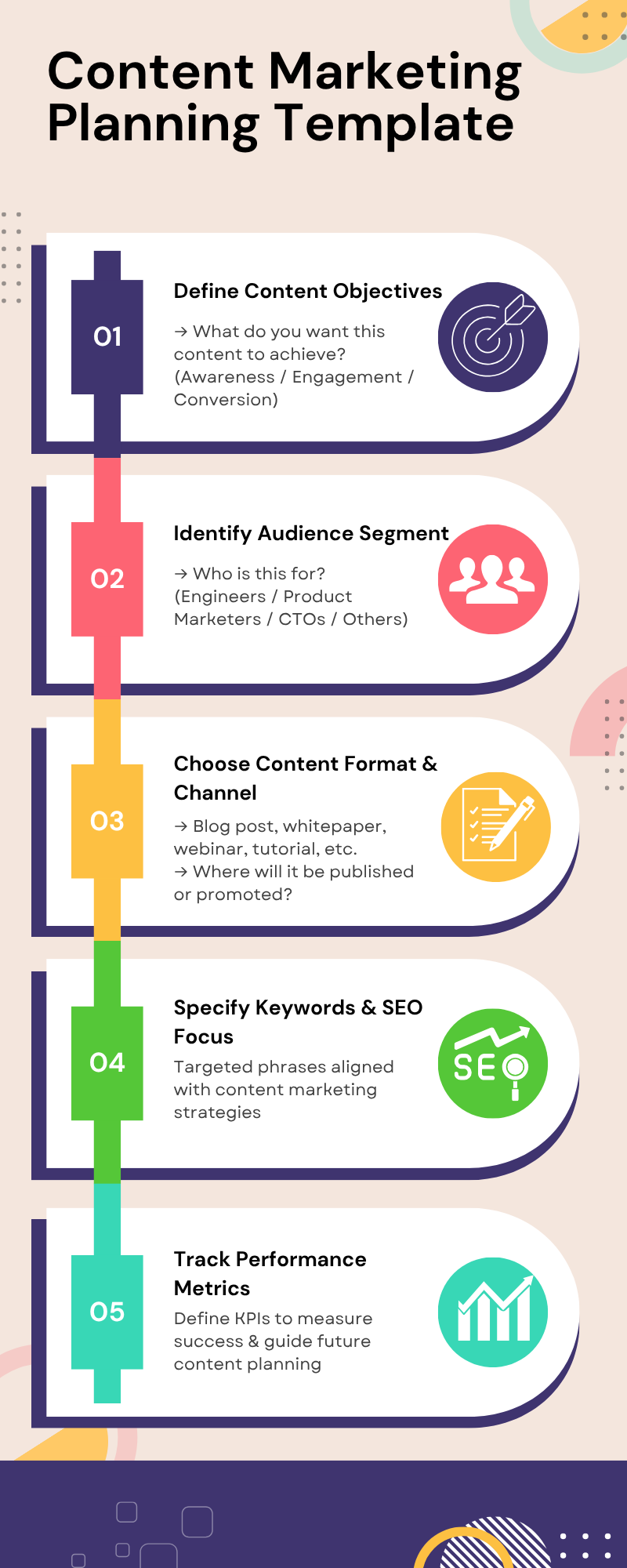
Spend enough time with cloud-native startups, and you’ll see the pattern. The product is technically brilliant. The engineering team is shipping fast. But the content? It’s either nonexistent, ad hoc, or stuck in the founder’s to-do list. And that’s a missed opportunity—especially now, when the content marketing industry is projected to reach a staggering $600 billion in 2024, highlighting its growing importance in modern go-to-market strategies.
We’ve seen this play out at every stage—from seed-funded DevOps startups to Series B infrastructure players. And the problem isn’t that these companies don’t value content. It’s that they haven’t built a content engine—a repeatable system that produces high-quality content without burning out the team.
At Writewyze, we help startups go from zero to a functioning content machine. Here’s our playbook for building a solid content strategy that actually scales.
What is content marketing for startups?
Simply put, content marketing for startups is the planned creation and distribution of valuable, relevant content with the goal of bringing in, engaging, and retaining a target audience in order to eventually generate profitable consumer action. Content marketing is more than just posting blog entries and social media updates for cloud-native startups. It involves developing a smart, scalable content strategy that complements your marketing funnels, buyer profiles, and product roadmap. This covers everything from thought leadership that speaks to CTOs and founders to technical content creating that addresses directly engineers.
Building awareness at the top of the funnel, followed by education and enablement in the middle, and then conversion-focused resources at the bottom, is how effective content marketing strikes a balance. Successful entrepreneurs use content production to promote sales, foster trust, and ease the purchasing process in addition to showcasing their products. A key component of startup content marketing is ongoing content planning and content repurposing. This ensures every asset works harder, reaches wider audiences, and feeds into a cohesive narrative. When done right, content marketing becomes a powerful engine that scales with your startup — fueling growth, building brand authority, and generating pipeline without burning out your team.
Content marketing planning template
Creating a robust content marketing planning template is essential for any cloud-native startup aiming to build a scalable and repeatable content engine. This template acts as your roadmap, helping you align your content strategy with business goals, audience needs, and marketing funnels.
A good template should include:

By using a content marketing planning template, startups avoid the common pitfall of scattered efforts and can build a consistent cadence of meaningful, valuable content. It also ensures your content creation process is smooth and scalable, crucial for startups moving fast but needing structure.
7 proven strategies to scale content
Want to scale your content without burning out your team? Start with these 7 proven strategies that help cloud-native startups turn ad hoc efforts into a repeatable, high-impact content engine.
1. Define Clear Content Objectives
The first step in building a content engine is knowing what you’re trying to achieve. That sounds obvious, but we’ve had countless content strategy calls where the goal is… “growth.” Which is vague and impossible to measure. Instead, break your objectives down by marketing funnels:
- TOFU (Top of Funnel): Drive awareness, build search engine visibility, and establish a brand voice.
- MOFU (Middle of Funnel): Educate buyers, explain use cases, and generate interest from evaluators.
- BOFU (Bottom of Funnel): Enable the sales team, handle objections, and drive conversions.
Each of these requires a different type of content. A whitepaper for a CISO is not the same as a technical tutorial for a DevOps lead. When objectives are clear, the rest of your digital marketing strategy becomes easier to architect. A good content strategy doesn’t just define the outcome, it defines business objectives, audience needs, and strategic alignment across the funnel.
2. Segment your audience (and write for them)
Too many content strategies assume a one-size-fits-all reader. That never works—especially in cloud-native where your audience ranges from deeply technical engineers to strategic decision-makers. Here’s how we help clients segment:
- DevRel and Engineers: Want credibility, depth, and real-world examples? Tutorials, architecture breakdowns, performance benchmarks—this is where technical content writing shines.
- Product Marketers: Need to understand positioning, integrations, and competitive edge. Case studies, product use cases, and comparison guides land well.
- Founders and CTOs: Care about strategy, roadmap alignment, and technical differentiators. Think thought leadership, product vision, and narrative storytelling.
- CMOs and Revenue Teams: Focused on business outcomes, GTM velocity, and category differentiation. Whitepapers, market POVs, and customer-proof points shine here.
One persona ≠ one channel. You’ll often find the same person moving across segments as their role evolves. That’s why content planning needs to map not just to persona—but also to their intent at each stage of the marketing funnel.
3. Pick the right channels and formats
We often see cloud-native teams put all their content bets on one channel—usually their blog or LinkedIn. That’s a mistake. Different audiences hang out in different places. Here’s a basic channel-to-persona map we often use:
- Engineers / DevRel: Hacker News, Reddit, community forums, GitHub READMEs, and docs.
- PMMs / GTM Leaders: LinkedIn, podcasts, curated newsletters.
- CTOs / Founders: Industry blogs, executive roundtables, long-form interviews.
- CMOs: Analyst reports, whitepapers, AMAs, webinars.
And don’t forget format diversity: A single whitepaper can be atomized into blog posts, tweet threads, sales slides, and email sequences.
One product explainer can become a webinar, a blog, a comparison table, and a case study.
Content repurposing isn’t a hack, it’s a strategy. It stretches your investment and keeps your message consistent across formats and touchpoints. It should be baked into your content strategy from day one.
4. Establish a production workflow
A content engine isn’t just about ideas—it’s about consistent execution. We’ve seen amazing strategies get stuck because teams didn’t have a workflow. Here’s the baseline system we implement for clients:
- Content Briefs: Every piece of content starts with a brief that outlines the audience, goal, keywords, format, and distribution plan.
- Templates & Frameworks: These reduce decision fatigue. Whether it’s a case study format or a blog outline, we templatize everything to simplify content creation.
- Content calendar: Centralized view of what’s in progress, what’s queued up, and what’s shipped. The calendar keeps your planning visible and manageable.
- Review and Approvals: Set clear expectations for who reviews what and when. A two-week review loop can kill momentum.
- Repurposing Plan: For every new piece, ask: how else can this be used? Break big assets into snackable formats and distribute them across channels.
If you’re working with a lean team (as most early-stage companies are), start with one owner and scale the workflow slowly. You don’t need a 6-person content team to build consistency—you just need clarity and rhythm. We’ve worked with startups who went from one blog a quarter to 4–5 high-quality content pieces a month, just by implementing this structure and aligning it with a long-term content strategy.
5. Modern SEO for technical content
SEO isn’t dead. But AI content mills have ruined a lot of what used to work. Here’s our approach to modern, sustainable SEO within a B2B content marketing context:
- Topical Authority: Don’t chase keywords randomly. Own a topic cluster deeply—like “Kubernetes security” or “observability at scale.”
- Real Search Intent: Write for what your audience Googles. Not just “DevOps best practices,” but things like “how to structure Terraform modules for multi-account AWS.”
- E-E-A-T Signals: Expertise, experience, authority, trust. Google still rewards content authored by real experts. We include engineer bylines, links to GitHub profiles, and surface credentials.
- Semantic Optimization: Think clusters, not keywords. When covering “multi-tenancy in SaaS,” also talk about isolation strategies, namespace design, and permission models.
6. Measure content ROI (Without getting lost in vanity metrics)
You can’t improve what you don’t measure. But you also can’t scale content if you’re chasing the wrong numbers. We break content metrics into 3 tiers:
- TOFU: Sessions, impressions, rankings, social shares.
- MOFU: Time on page, CTA clicks, newsletter signups, return visits.
- BOFU: Demo requests, sales team usage, assisted pipeline.
But here’s the key: not all content should be measured by revenue. A great product explainer might not drive direct signups—but it’ll reduce time spent on sales calls. A technical deep dive might not rank—but it’ll support pipeline conversations with architects. We recommend tagging existing content in your CRM as part of sales workflows. This helps track influence on pipeline and surfaces what reps use.
7. Real advice from the trenches
We’ve helped dozens of cloud-native teams build their content muscle. Here’s what we’ve learned the hard way:
- Quality beats volume. One sharp, effective content post outperforms five fluff pieces.
- Start early. You don’t need a full GTM team. Some of our best clients started with one marketer and a founder ghostwriting.
- Collaborate across teams. Product, engineering, and GTM should all contribute. Content isn’t a silo, it’s a multiplier.
- Think long-term. Content isn’t a hack. It’s infrastructure. You wouldn’t build brittle infra—don’t build brittle content.
Content marketers who focus on long-term value creation, not just short-term traffic bumps, are the ones who actually build a scalable marketing strategy. This means aligning with teams, refining based on KPIs, and continuously turning learnings into actionable insights.
Turn content into a growth engine
If you’re building a cloud-native product, you’re already solving hard problems. Content shouldn’t be another one. With the right systems, you can create content that scales alongside your team, pipeline, and product. We’ve helped teams go from chaos to consistency and from silence to sales. If you’re ready to take content seriously, let’s talk.
→ Book a discovery call to explore how Writewyze can help build your content engine.
